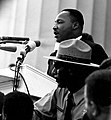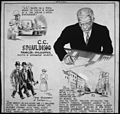The civil rights movement portal The civil rights movement was a social movement and campaign in the United States from 1954 to 1968 which aimed to abolish legalized racial segregation, discrimination, and disenfranchisement in the country, which was most commonly employed against African Americans. The movement had origins in the Reconstruction era during the late 19th century, and had modern roots in the 1940s. After years of direct actions and grassroots protests, the movement made its largest legislative and judicial gains during the 1960s. The movement's major nonviolent resistance and civil disobedience campaigns eventually secured new protections in federal law for the civil rights of all Americans. After the American Civil War and subsequent abolition of slavery in the southern states in 1865, the three Reconstruction Amendments to the United States Constitution had granted emancipation and constitutional rights of citizenship to all African Americans, the majority of whom had recently been enslaved. For a short period of time, African-American men voted and held political office, but as time went on Blacks in the South were increasingly deprived of civil rights, often under racist Jim Crow laws, and were subjected to discrimination and sustained violence by White supremacists. African Americans who moved to the North to enhance their prospects in the Great Migration also faced barriers in employment and housing. Over the following century, various efforts were made by African Americans to secure their legal and civil rights, such as the civil rights movements of 1865–1896 and of 1896–1954. The movement was characterized by nonviolent mass protests and civil disobedience following highly publicized events such as the lynching of Emmett Till in 1955. These included boycotts such as the Montgomery bus boycott, "sit-ins" in Greensboro and Nashville, a series of protests during the Birmingham campaign, and a march from Selma to Montgomery. The movement was led by Martin Luther King Jr., and press coverage of police violence against protesters with fire hoses and dogs during the Birmingham campaign increased its public support. Discrimination was often supported by courts, including by the Supreme Court in its 1896 decision Plessy v. Ferguson, which upheld the doctrine of separate but equal. At the culmination of a legal strategy pursued by African Americans, in 1954 the Supreme Court struck down the underpinnings of laws allowing racial discrimination as unconstitutional in Brown v. Board of Education (1954). The Warren Court made further pro–civil rights rulings in cases such as Browder v. Gayle (1956) and Loving v. Virginia (1967), banning segregation in public schools and public transport, and striking down state laws against interracial marriage. In the 1960s, after the March on Washington in 1963, moderates in the movement worked with the United States Congress to achieve the passage of several significant pieces of federal legislation that authorized oversight and enforcement of civil rights laws. The Civil Rights Act of 1964 banned all discrimination based on race, color, religion, sex, and national origin, including in schools, employment, and public accommodations. The Voting Rights Act of 1965 restored and protected voting rights for minorities and authorized oversight of registration and elections in areas with historic under-representation of minority voters. The Fair Housing Act of 1968 forbade property owners from discriminating in the rental or sale of housing. (Full article...) Selected article -The Greensboro sit-ins were a series of nonviolent protests in February to July 1960, primarily in the Woolworth store — now the International Civil Rights Center and Museum — in Greensboro, North Carolina, which led to the F. W. Woolworth Company department store chain removing its policy of racial segregation in the Southern United States. While not the first sit-in of the civil rights movement, the Greensboro sit-ins were an instrumental action, and also the best-known sit-ins of the civil rights movement. They are considered a catalyst to the subsequent sit-in movement, in which 70,000 people participated. This sit-in was a contributing factor in the formation of the Student Nonviolent Coordinating Committee (SNCC). (Full article...) General imagesThe following are images from various civil rights movement-related articles on Wikipedia.
Related portalsWikiProjectsSelected biography -John Robert Lewis (February 21, 1940 – July 17, 2020) was an American politician and civil rights activist who served in the United States House of Representatives for Georgia's 5th congressional district from 1987 until his death in 2020. He participated in the 1960 Nashville sit-ins and the Freedom Rides, was the chairman of the Student Nonviolent Coordinating Committee (SNCC) from 1963 to 1966, and was one of the "Big Six" leaders of groups who organized the 1963 March on Washington. Fulfilling many key roles in the civil rights movement and its actions to end legalized racial segregation in the United States, in 1965 Lewis led the first of three Selma to Montgomery marches across the Edmund Pettus Bridge, where, in an incident that became known as Bloody Sunday, state troopers and police attacked Lewis and the other marchers. A member of the Democratic Party, Lewis was first elected to the U.S. House of Representatives in 1986 and served 17 terms. The district he represented included most of Atlanta. Due to his length of service, he became the dean of the Georgia congressional delegation. He was one of the leaders of the Democratic Party in the House, serving from 1991 as a chief deputy whip and from 2003 as a senior chief deputy whip. He received many honorary degrees and awards, including the Presidential Medal of Freedom in 2012. (Full article...) Selected image - During the Civil Rights March on Washington, D.C. — Leaders marching from the Washington Monument to the Lincoln Memorial, (August 28, 1963).
Did you know?
TopicsSubcategoriesThings to doAssociated WikimediaThe following Wikimedia Foundation sister projects provide more on this subject:
Discover Wikipedia using portals
|






















































